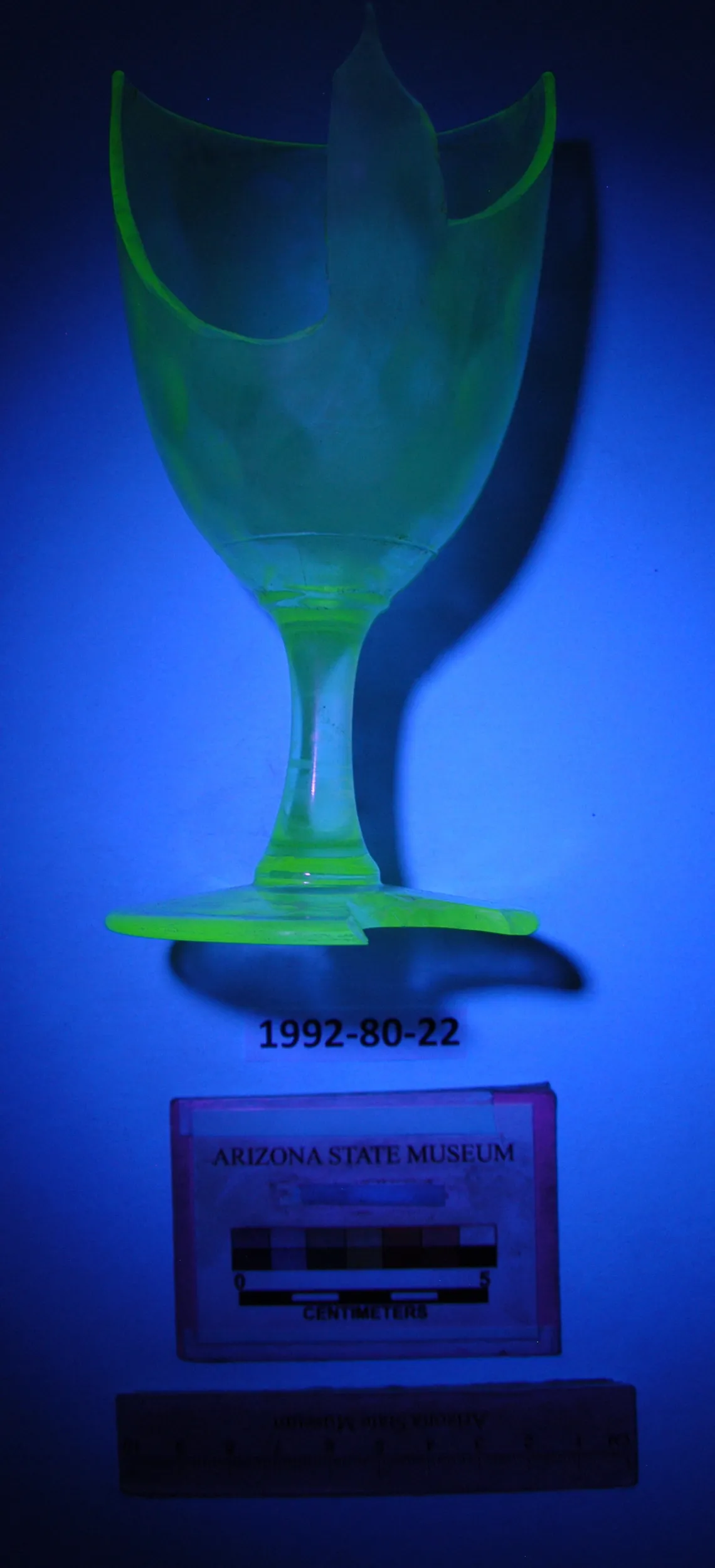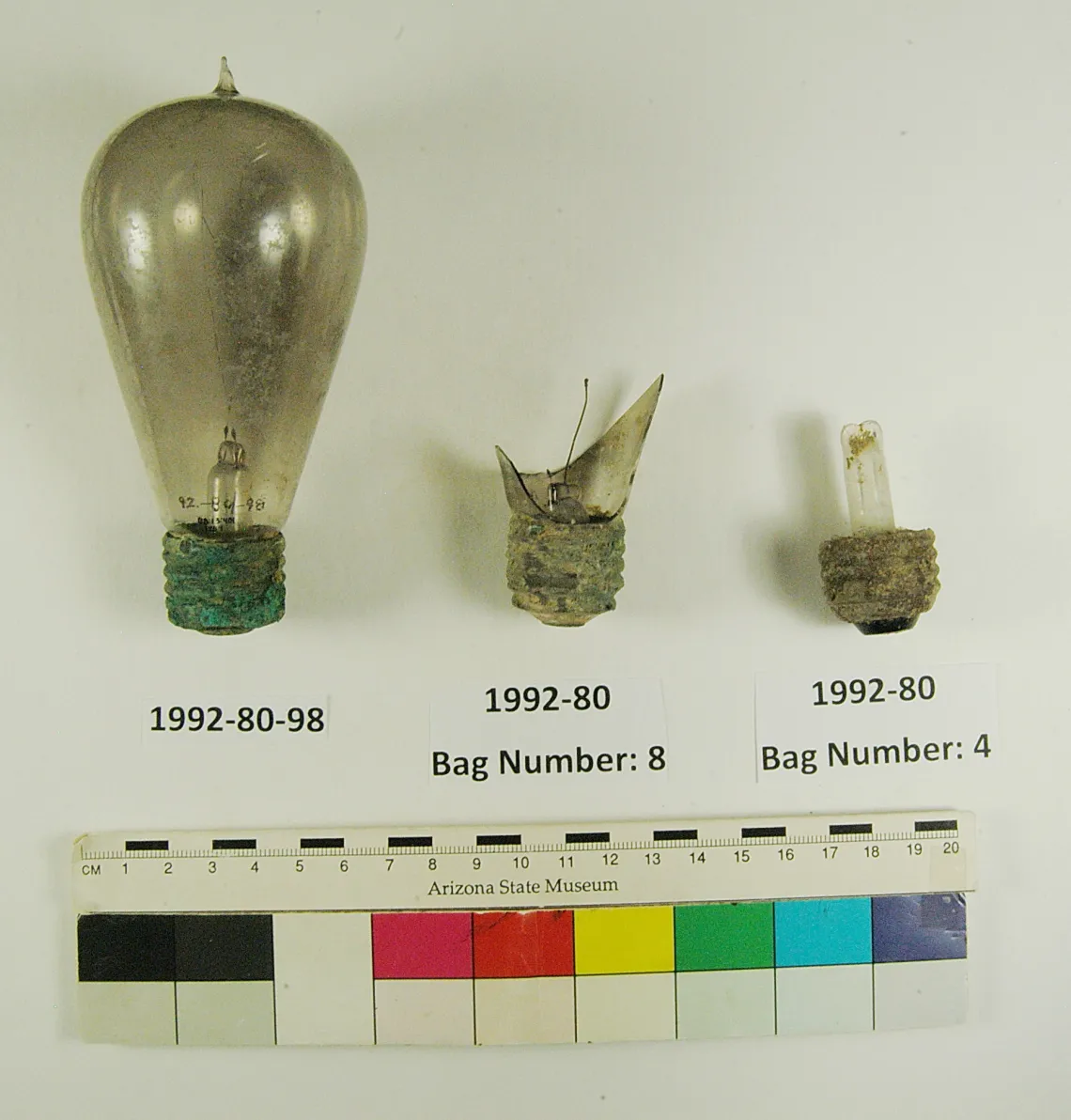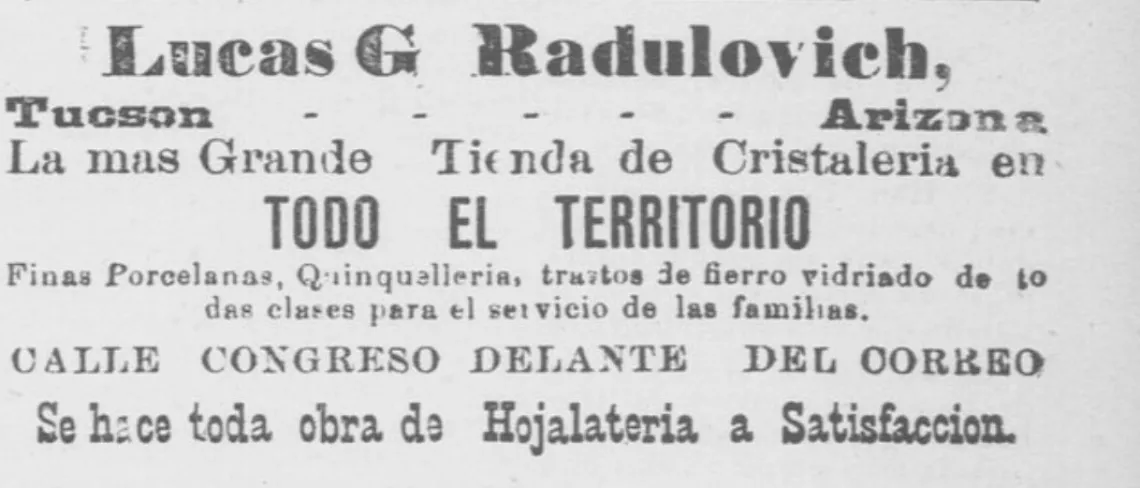
AP 1992-80-22: the glass goblet illuminated with ultraviolet light which is causing it to glow neon green.
By Antonio Moreno, ASM Archaeological Repository Collections Management Intern
Spring 2023
Introduction
For the spring of 2023, me and a group of other people spent my semester on a research project regarding a uranium glass goblet (1992-80-22) excavated from Block 83 in downtown Tucson, Arizona, and currently curated the Arizona State Museum (ASM) Archaeological Repository collections. The other members of the team working on this project include a fellow intern Sandra Guerrero, the coordinator and leader of the project Dr. Kathryn MacFarland, Manager of the Repository, and the Conservator who previously conducted a granular analysis of the object and consulting on the project, Isabel Schneider. The uranium glass goblet was excavated from what is now The Ronstadt Transit Center and what used to be Block 83 in Downtown Tucson (Mabry et al. 1994). The goblet was found in Lot 6, a plot of land on top of which the Radulovich family built a house. The Radulovich family lived there from 1893-1902 (Mabry et al.1994). After they left, it was subsequently occupied by another family before it was torn down. More important to the research project than the house, we focused on Feature 18, a privy pit that existed on the “south edge of the lot behind the house” (1994: 47) the specific findspot. The goblet was illustrated in the project report (1994: Figure 3.15B) and thus became a part of the catalog collection. The report describes the object as “stemmed-ware, goblet, plain” (1994: 141). The observation that it was made of uranium glass was not discovered until the summer of 2022 by Dr. MacFarland and other Repository personnel. The object can be described as a glass goblet with a short, curved stem and a large cup that takes up more than half of the object’s height and a flat base, with a polka-dot-like pattern imprinted into the glass, two large shards missing from the cup portion of the goblet and one shard missing from the base, and the glass has a cloudy yellow color to it. Overall, the presence of the goblet in this collection is noteworthy because it shows how connected the small city of Tucson was to the rest of the world during this period and because the presence of a uranium glass goblet in a city with very recent access to electricity and electric lighting creates many fascinating questions to answer.
Once the yellow glass used to manufacture the goblet was identified as uranium glass, the presence of uranium in the glass was confirmed (Schneider 2022), and we learned more about it, many questions were raised and that led to this research project. For example: How did it get to Tucson? Did they know it could glow? Were products like this goblet sold in the Radulovich glass and ceramic shop and was this a selling point? Uranium glass today is known for its neon glow under ultraviolet lights so the question that the project eventually centered around was whether the family, or any Tucson resident, that owned the uranium glass had the ability to make it glow when they lived in Tucson in the late 19th century, prior to having access to the ultraviolet light bulbs we are used to seeing today.

AP-1992-80-98: a lightbulb with smoky glass and rusted base.
AP-1992-80 Bag number 8: a lightbulb fragment with a rusted base, shards of glass, and loose filament.
AP-1992-80 Bag number 4: a lightbulb fragment with a rusted base and filament in glass.
Project Methodology
The first step of the project was learning and reading about why and how uranium glass glows, the history of uranium glass as a commercial product, as well as how light and light bulbs create. We learned that uranium was discovered by a German chemist named Klaproth in 1789 and was used in the creation of glass very soon after. Uranium glass production was at its height between 1830 and 1940 (Strahan 2001:181). Uranium could be used to make many different glass colors, such as red-orange, dark green, and black, but one of the more common types was the canary yellow or “vaseline” glass (2001:181), which is what the uranium glass goblet is made of. One of the most commonly known features of uranium glass is that they can glow under ultraviolet light.
It was also important to begin learning more about the Radulovich family during this period to try to best understand what they would have owned and had access to. The next step was assessing the collection in the Repository that contains the uranium glass goblet and entering any information on the collection that was not present in the cataloging database. Some of the missing information that was filled in was provenience information for the objects, the information present on the catalog card, and the catalog card descriptions. The next step in this project was looking through the bulk collection of the collection containing the uranium goblet to see if any light sources were recovered from the site that would have belonged to the family that owned the property. To decide which boxes of the bulk collection to look through for these objects, we constructed a spreadsheet, listing the boxes by the material and the features of interest (i.e., Feature 18). We then selected the boxes based on whether they were associated with the Radulovich Household and whether the features they were excavated lined up roughly with when the Radulovich family lived on the property. Following this, we created a list of all the boxes matching our criteria and began searching through them for any lighting sources we could find. In these boxes three lightbulb fragments were found, documented and photographed.
While looking for and finding light sources in the feature where the uranium goblet came from is important, it was also important to learn about the context in which it came from to answer our research question: the family that owned the cup. The family that presumably owned the goblet were the Radulovich’s, Austrian immigrants who bought the lot in 1891 and subsequently built a house on the property in 1893 (Mabry et al. 1994: 45). After they sold the house in 1902, they moved to California and later Austria (Mabry et al. 1994). The patriarch of the household, Lucas Radulovich, owned two businesses: a glassware and ceramics store and a drugstore, both of which operated near his home. The only other known member of the household was Lucas’ wife, Lucy Radulovich (Thiel 2009:15). No information could be found regarding children they may or may not have had. The family that bought the house from the Radulovichs were the Brenas, which included Rosario Brena, Maria Cotten Brena, and their two sons Rosario jr. and Pedro. They lived in that house from 1902 until 1920.

An advertisement for Lucas Radulovich's glass and ceramic store, written in Spanish, that was published in El Fronterizo (Velasco 1897).
Research Scope
This project immediately struck me because rather than the research focusing on an entire community or large group like most archaeological analysis for various archaeology classes I have completed. Instead, this project required that I study a single family in a limited window of time along with the surrounding community for context. This is what archaeologists call household archaeology, which is a form of archaeology that specializes in and focuses on the household unit and its own relationship to material culture. In this case a household can be defined as “the most common social component of subsistence, the smallest and most abundant activity group” (Wilk and Rathje 1982:618). This change in what was being analyzed allowed me to explore alternate forms of research that I had not engaged in before. For one, the scope of investigation was extremely narrowed. Rather than an entire community with many different people, I was focusing on individual people, only two people and the business of one man in that family: Lucas Radulovich’s glassware and ceramics business. Different strategies regarding where to look for information also had to be taken for this project. Like most archaeological projects, this project involved studying the material culture of the people central to the project, but it also required new and alternative strategies such as looking through newspaper’s contemporary to the time of the family’s residence and city records from the same period.
The change of scope both in terms of my research as well as my mindset was the biggest adjustment I made for this project. For most of my undergraduate archaeological research I have been tasked with analyzing anything from entire multi-century cultures to a small community in a single region in a single period. A unit as small as a single family is something I never considered I would focus on. Another change in scope due to studying a smaller group of people is that there is a smaller area of study, location-wise. When looking at the material culture of this family, I could only search through their personal trash piles that were excavated around their former house. These were all the was left of their household, archaeologically, so this limited the scope of actual physical items that belong to this family that could be used for answering our questions. This was beneficial because it would allow us to find only objects exclusively relevant to this family but this limit in location also acted as a double-edged sword. The other side of this sword is that if the family did not dispose of and bury a specific kind of item at all, there is no information regarding that kind of object. Luckily this issue was not one me and the others working on this project ran into because we were able to find light bulb fragments! These fragments will help us learn copious amounts of information about the lighting the family had available to them because the period and location is so specific. Another change in scope due to studying a smaller group of people is that there is a smaller period of study, specifically having a nine-year window of time. This was advantageous in that it allowed for hard lines of which objects should be focused on and which should not since many objects from that period were either patented at a certain time, labeled with things such as manufacturing date and expiration date. Like the limit in location, this hard limit set on the parameters of research also has the drawback of any object falling outside the limits not being appropriate for the project. The changes in scope such as the amount of people, the area, and the period led us to using different methods that would not be used on other projects.
New Strategies
The change in strategies for this project was one of the most interesting aspects of this project to me. Most archaeological projects involve looking at wider patterns among material culture. There was an accessible material culture for the family being studied in this project but the number of artifacts available to study were much smaller than if I was studying a large group of culture, and there were even less objects that were relevant to the topic specifically being researched. One strategy used to give us more information on this family and the way people lived in Tucson during this period was the use of newspapers. For this I used the Arizona Memory Project which is a free to use archive of Arizona newspapers through time that is run by the Arizona state government. The use of newspapers allowed for many benefits that I did not know existed. One of the benefits of using newspapers is that if the database is up to date, it is possible to search for specific keywords or names and see every time that word or name is mentioned, which makes looking at many newspaper articles in a period much easier. Another useful part of using newspapers is that it allows the researcher to learn copious amounts of information about what happened during the period. Even when a newspaper only mentioned the Radulovich family in a single sentence, reading the various news articles surrounding the sentence I could get a large and detailed picture of what life was like around the time of the newspaper’s publication. The final and most useful part of using newspapers for this project is that you learn things that would be difficult to learn from looking exclusively at a group’s material culture. Many events, stories, and single moments are not preserved in the material culture, so studying the newspapers gives a new perspective on what was happening in the period that is being studied. Other than the material culture and local newspapers, I was also able to investigate publicly available government records from the period and gain information regarding their property, their house’s architect, and much more official government information. They filled in the gaps that were left, which made them useful in creating a cohesive idea of where and how this family lived when they lived in Tucson.
Conclusion
I am extremely grateful for being able to work on this project, as being able to study a single family rather than an entire community allowed me to gain a new perspective on archaeological research. During this project, I not only learned about light bulbs, uranium glass, and early electricity but I also learned many new strategies. I learned how useful changing scope by narrowing down into studying something small can be. I also learned how analyzing smaller groups can allow for learning more about the personal lives of specific people rather than learning about community-wide actions and movements. Lastly, I learned that the information provided by documentation of a more recent era allows for different information to be preserved, and this allows for various kinds of research than what can be achieved with archaeology done for more ancient time periods. This project is one that I will think of in the future to get excited about trying something different in terms of the strategies I choose, because now I know how much a project like that can teach me.
Bibliography:
Homer Thiel, J. 2009. “Archaeological Investigations and Data Recovery at Historic Block 83, Tucson, Pima County, Arizona.” Tucson, Arizona: Desert Archeaology, Inc.
Mabry, Jonathan B., James E. Ayres, and Regina L. Chapin-Pyritz. 1994. “Tucson at the Turn of the Century: The Archeology of Block 83.” Tucson, Arizona: Center for Desert Archaeology.
Schneider, Isabel. 2022. “Conservation Technical Report.” Tucson, AZ: Arizona State Museum.
Strahan, Donna. 2001. “Uranium in Glass, Glazes and Enamels: History, Identification and Handling.” Studies in Conservation 46 (3): 181. https://doi.org/10.2307/1506809.
Velasco, Carlos S. 1897. El Fronterizo, April 3, 1897. https://azmemory.azlibrary.gov/nodes/view/95044?#idx344782.
Wilk, Richard R., and William L. Rathje. 1982. “Household Archaeology.” American Behavioral Scientist 25 (6): 617–39. https://doi.org/10.1177/000276482025006003.





